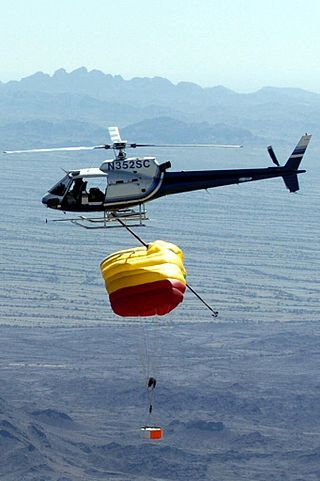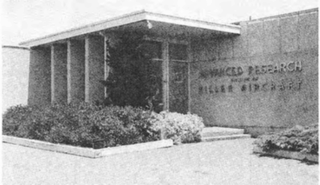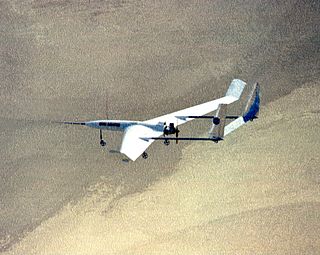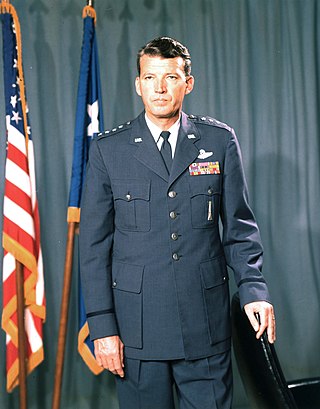Related Research Articles

Project Mercury was the first human spaceflight program of the United States, running from 1958 through 1963. An early highlight of the Space Race, its goal was to put a man into Earth orbit and return him safely, ideally before the Soviet Union. Taken over from the US Air Force by the newly created civilian space agency NASA, it conducted 20 uncrewed developmental flights, and six successful flights by astronauts. The program, which took its name from Roman mythology, cost $2.68 billion. The astronauts were collectively known as the "Mercury Seven", and each spacecraft was given a name ending with a "7" by its pilot.

A vertical take-off and landing (VTOL) aircraft is one that can take off and land vertically without relying on a runway. This classification can include a variety of types of aircraft including helicopters as well as thrust-vectoring fixed-wing aircraft and other hybrid aircraft with powered rotors such as cyclogyros/cyclocopters and gyrodynes.

Mercury-Redstone 3, or Freedom 7, was the first United States human spaceflight, on May 5, 1961, piloted by astronaut Alan Shepard. It was the first crewed flight of Project Mercury. The project had the ultimate objective of putting an astronaut into orbit around the Earth and returning him safely. Shepard's mission was a 15-minute suborbital flight with the primary objective of demonstrating his ability to withstand the high g-forces of launch and atmospheric re-entry.

Mercury-Redstone 4 was the second United States human spaceflight, on July 21, 1961. The suborbital Project Mercury flight was launched with a Mercury-Redstone Launch Vehicle, MRLV-8. The spacecraft, Mercury capsule #11, was nicknamed Liberty Bell 7. It was piloted by astronaut Virgil "Gus" Grissom.

Mercury-Atlas 8 (MA-8) was the fifth United States crewed space mission, part of NASA's Mercury program. Astronaut Walter M. Schirra Jr., orbited the Earth six times in the Sigma 7 spacecraft on October 3, 1962, in a nine-hour flight focused mainly on technical evaluation rather than on scientific experimentation. This was the longest U.S. crewed orbital flight yet achieved in the Space Race, though well behind the several-day record set by the Soviet Vostok 3 earlier in the year. It confirmed the Mercury spacecraft's durability ahead of the one-day Mercury-Atlas 9 mission that followed in 1963.

A reusable launch vehicle has parts that can be recovered and reflown, while carrying payloads from the surface to outer space. Rocket stages are the most common launch vehicle parts aimed for reuse. Smaller parts such as rocket engines and boosters can also be reused, though reusable spacecraft may be launched on top of an expendable launch vehicle. Reusable launch vehicles do not need to make these parts for each launch, therefore reducing its launch cost significantly. However, these benefits are diminished by the cost of recovery and refurbishment.

Gemini 6A was a 1965 crewed United States spaceflight in NASA's Gemini program. The mission, flown by Wally Schirra and Thomas P. Stafford, achieved the first crewed rendezvous with another spacecraft, its sister Gemini 7. Although the Soviet Union had twice previously launched simultaneous pairs of Vostok spacecraft, these established radio contact with each other, but they had no ability to adjust their orbits in order to rendezvous and came no closer than several kilometers of each other, while the Gemini 6 and 7 spacecraft came as close as one foot (30 cm) and could have docked had they been so equipped.

The Boeing X-20 Dyna-Soar was a United States Air Force (USAF) program to develop a spaceplane that could be used for a variety of military missions, including aerial reconnaissance, bombing, space rescue, satellite maintenance, and as a space interceptor to sabotage enemy satellites. The program ran from October 24, 1957, to December 10, 1963, cost US$660 million, and was cancelled just after spacecraft construction had begun.

The Space Shuttle Solid Rocket Booster (SRB) was the first solid-propellant rocket to be used for primary propulsion on a vehicle used for human spaceflight. A pair of these provided 85% of the Space Shuttle's thrust at liftoff and for the first two minutes of ascent. After burnout, they were jettisoned and parachuted into the Atlantic Ocean where they were recovered, examined, refurbished, and reused.

The Lockheed Martin X-33 was a proposed uncrewed, sub-scale technology demonstrator suborbital spaceplane that was developed for a period in the 1990s. The X-33 was a technology demonstrator for the VentureStar orbital spaceplane, which was planned to be a next-generation, commercially operated reusable launch vehicle. The X-33 would flight-test a range of technologies that NASA believed it needed for single-stage-to-orbit reusable launch vehicles, such as metallic thermal protection systems, composite cryogenic fuel tanks for liquid hydrogen, the aerospike engine, autonomous (uncrewed) flight control, rapid flight turn-around times through streamlined operations, and its lifting body aerodynamics.

A drogue parachute, also called drag chute, is a parachute designed for deployment from a rapidly moving object. It can be used for various purposes, such as to decrease speed, to provide control and stability, as a pilot parachute to deploy a larger parachute or a combination of these. Vehicles that have used drogue parachutes include multistage parachutes, aircraft, and spacecraft recovery systems.

Mid-air retrieval is a technique used in atmospheric reentry when the reentering vehicle is incapable of a satisfactory unassisted landing. The vehicle is slowed by means of parachutes, and then a specially-equipped aircraft matches the vehicle's trajectory and catches it in mid-air.

The ballute is a parachute-like braking device optimized for use at high altitudes and supersonic velocities.

Hiller Aircraft Company is an American private aerospace company, based in Firebaugh, California. It was founded in 1942 as Hiller Industries by Stanley Hiller to develop helicopters.

The Saturn C-3 was the third rocket in the Saturn C series studied from 1959 to 1962. The design was for a three-stage launch vehicle that could launch 45,000 kilograms (99,000 lb) to low Earth orbit and send 18,000 kilograms (40,000 lb) to the Moon via trans-lunar injection.

The DC-3 was one of several early design proposals for the NASA Space Shuttle designed by Maxime Faget at the Manned Spacecraft Center (MSC) in Houston. It was nominally developed by North American Aviation (NAA), although it was a purely NASA-internal design. Unlike the design that eventually emerged, the DC-3 was a fully reusable launch vehicle two-stage-to-orbit spaceplane design with a small payload capacity of about 12,000 lb (5,400 kg) and limited maneuverability. Its inherent strengths were good low-speed handling during landing, and a low-risk development that was relatively immune to changes in weight and balance.
Aircraft have different ways to take off and land. Conventional airplanes accelerate along the ground until reaching a speed that is sufficient for the airplane to takeoff and climb at a safe speed. Some airplanes can take off at low speed, this being a short takeoff. Some aircraft such as helicopters and Harrier jump jets can take off and land vertically. Rockets also usually take off vertically, but some designs can land horizontally.

A Mars aircraft is a vehicle capable of sustaining powered flight in the atmosphere of Mars. So far, the Mars helicopter Ingenuity is the only aircraft ever to fly on Mars, completing 72 successful flights covering 17.242 km (10.714 mi) in 2 hours, 8 minutes and 48 seconds of flight time. Ingenuity operated on Mars for 1042 sols, until its rotor blades, possibly all four, were damaged, causing NASA to retire the craft.

A drop test is a method of testing the in-flight characteristics of prototype or experimental aircraft and spacecraft by raising the test vehicle to a specific altitude and then releasing it. Test flights involving powered aircraft, particularly rocket-powered aircraft, may be referred to as drop launches due to the launch of the aircraft's rockets after release from its carrier aircraft.

While the United States Space Force gained its independence on 20 December 2019, the history of the United States Space Force can be traced back to the beginnings of the military space program following the conclusion of the Second World War in 1945. Early military space development was begun within the United States Army Air Forces by General Henry H. Arnold, who identified space as a crucial military arena decades before the first spaceflight. Gaining its independence from the Army on 18 September 1947, the United States Air Force began development of military space and ballistic missile programs, while also competing with the United States Army and United States Navy for the space mission.
References
- ↑ A proposal to NASA: Rotary Wing system for Booster Recovery. Report No.65-5, Hiller Advanced Planning & Research Division, Hiller Aircraft company, Palo Alto, California, 1 May 1965
- ↑ Day, Dwayne, Monster chopper, The Space Review, 28th January 2008, https://www.thespacereview.com/article/1045/1
- ↑ The Hiller Air Tug, Hiller Aviation Museum, 23rd September 2016, https://www.youtube.com/watch?v=MHaxySnEPTc